
Eileen Agar
British, 1899-1991
Untitled (figure with cithara), 1942
watercolor on pressed board
13 1/2 x 9 7/8 in.
SBMA, London Collectors' Group Fund
1987.37.2

1927 photo of Eileen Agar by Cecil Beaton
COMMENTS
In trying to find a suitable subject for today’s post I came across an interesting female Surrealist. Born in Argentina but living most of her life in England, Eileen Agar was a painter and a sculptor. The extensive use of found objects in her work greatly appeals to me.
In her autobiography A Look at My Life (1988), Eileen Agar said that as an artist ‘one must have a hunger for new colour, new shapes and new possibilities of discovery’. The lyricism and vibrant colouring of Collective Unconscious is representative of her late work. The composition combines Surrealist elements with its abstracted “cut-out” forms and painterly surface.”
A biography on the Royal Academy of Arts, London, website states:
Born in Buenos Aires in 1899, Agar came to London aged six. She studied at the Slade School of Fine Art (1921-1924) before travelling to Paris and Spain with her first husband, Robin Bartlett. In 1926 Agar began a relationship with the Hungarian writer Joseph Bard, who she married in 1940. In 1929 she moved to Paris set up a studio and studied under Franti’ek Foltýn (1891-1976) who she said encouraged her to free herself ‘from the cul-de-sac of representational painting, by learning the principles of abstract painting, and experimenting with colour as well as form.’
Agar was the only British artist to have work included in the International Surrealist Exhibition at the New Burlington Galleries in 1936. Although she is often categorised as a Surrealist, Agar was equally interested in abstraction and did not strictly adhere to the tenets of any particular art movement. Agar was elected a Senior Member of the Royal Academy in 1988. “
From 1936 she experimented with automatic techniques and new materials, taking photographs and making collages and objects, for example The Angel of Anarchy (fabric over plaster and mixed media, 1936–40; London, Tate).
Surrealism in art, poetry, and literature utilizes numerous unique techniques and games to provide inspiration. Many of these are said to free imagination by producing a creative process free of conscious control. The importance of the unconscious as a source of inspiration is central to the nature of surrealism.
The Surrealist movement has been a fractious one since its inception. The value and role of the various techniques has been one of many subjects of disagreement. Some Surrealists consider automatism and Surrealist games to be sources of inspiration only, while others consider them as starting points for finished works. Others consider the items created through automatism to be finished works themselves, needing no further refinement.”
by jane dávila
https://raggedclothcafe.com/2007/08/08/eileen-agar-surrealist-games-by-jane-davila/
SBMA CURATORIAL LABELS
Like the Picasso print also in this exhibition, Agar looked to ancient Greek culture and to the long history of representational art with recognizable subjects. Here the body of a nude woman holds a cithara, an ancient instrument that the Greeks first used to accompany the reading of poetry, dances, and songs. She is superimposed on the head of another person, probably a woman. On top of that, the artist added a red-orange lattice. Then, she covered the frame with marks, giving an effect of a picture within a picture within a picture. While she always resisted the name, Agar was included in the First British Surrealist Exhibition of 1936, and for ever after found herself grouped with them, though her work varied considerably over her long life and career.
- Serenity and Revolution, 2024
